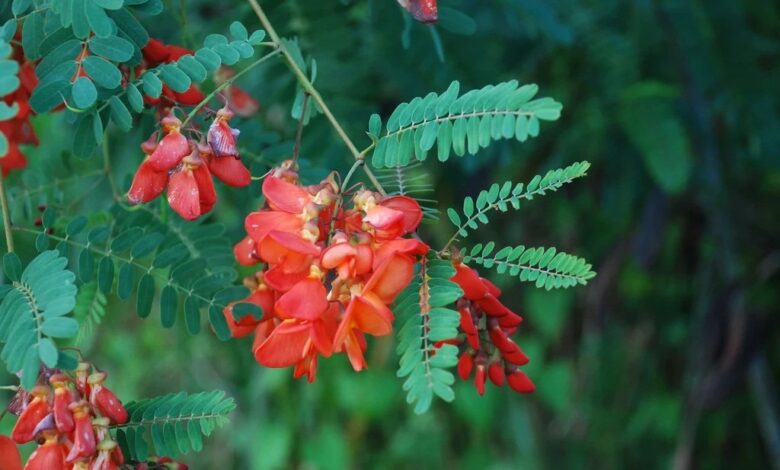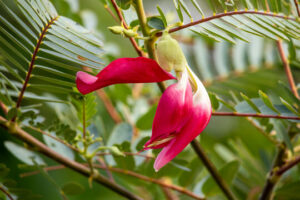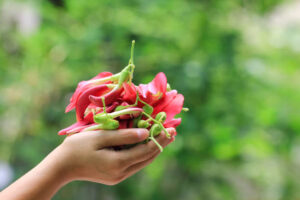Sesbania Punicea the Radiant Red Blossom

The red Sesbania punicea invasive plant is a weed that has become increasingly troublesome in the wetland and riparian ecosystems in California. The current methods of control concentrate on manual removal and then the application of herbicides. Even though this approach is efficient in eliminating old stands, the effect only lasts a few days because having a huge seed bank leads to rapid growth and germination of seeds. We analyzed the number of seed banks under stands with different densities and assessed the possibility of inundation and tarping for the control of the seed banks of Red Sesbania Punicea. Likely, the amount of red sesbania punicea seeds that were viable within the soil was substantially higher in high-density plants in comparison to lower-density stands. The results for tarping and inundation tests were not consistent. Inundation that was sustained for a long time significantly reduced the survival rate of seeds that germinated compared to the controls, while also leading to a statistically significant decrease in the rate of germination. Seven months after tarping during the winter/fall growing seasons, the study did not show any substantial impact on the red sesbania seedling quantity, stump resprout amount, or length. The rate of germination was greatly reduced after prolonged exposure to temperatures up to 60 °C; however, low temperatures didn’t affect the rate of germination. Red Sesbania punicea is resistant to tarping as an effective method of control and, in particular, in experimental settings.
The Legume Family

The Genus Sesbania Punicea is part of the bigger category of legumes. The family of legumes is split into three different subfamilies. Mimosoidaceae (80 genera and 3200 species) Caesalpinioideae (2,000 species in 170 genera) Faboideceae (14,000 species in more than 470 genera) The Genus Sesbania is part of the broadest family of legumes called the Faboideceae family. Faboideceae. They are Mimosoideae, and the Faboideae subfamilies tend to be monophyletic. However, the Caesalpinioideae subfamily is thought to be paraphyletic. The flowers bloom late in spring and blossom until fall. The species blooms throughout the summer months throughout the United States and from November through the beginning of January in South Africa. When the carpel structure is dried out, the seeds are scattered at the foot of the stem. Seed coats are impermeable and can be dispersed by water. The reason for this is the chemical callose. Therefore, they can be found near streams and rivers. The species is usually located on the roadsides, likely imported as the soil used for construction. The species can tolerate shade. Seedlings can create flowers and seeds in three months. However, flowering usually occurs in the second year. It can also tolerate freezing temperatures, but only for a short period of time. It is a native of Brazil, Argentina, Paraguay, and Uruguay. Sesbania punicea has expanded not just to a portion of Africa as well as different areas of South America and much of the southern coastline within the United States. Due to its water-related demands, the species is usually located in coastal wetlands. Additionally, it creates thickets that are dense and flourish in extremely rough terrain. It was identified as Sesbania punicea, often referred to as red sesbania It was my first time to discover that it was not indigenous to Florida; however, it is a South American plant that was introduced into the U.S. as an ornamental by the horticultural trade. While I was aware that it has been invasive in some parts of Florida, I wasn’t so concerned as I only observed one plant, that I had not seen in any other place. I am sorry that I wasn’t more concerned. The last time I was there, I stumbled upon some flowers in the vicinity of Apalachicola. I also remember seeing an area of seeds from plants belonging to the legume family. I’ve since realized could be Sesbania in the vicinity of an electric line that runs through Tallahassee. However, I wasn’t too concerned.
Morphology

The leaves of deciduous plants are compound and alternate. Five to 20 pairs of circular leaves are found on one stem. The leaf margins are typically complete, with no or few serrations. Every leaflet is rectangular and has an elongated edge. Leaflets have stipules, which are generally not noticeable. The flowers and fruit droop around the top of the plant. The stems of this plant are quite slim and green. They change to a darker reddish-brown when they reach maturity. The bark can vary from grey-brown through Sesbania Punicea, with distinct horizontal lenticulars. The flowers are pea-shaped and between 2 and 3 centimeters in length, usually red-orange or red-purple. They usually run races. The legume family is the most prominent, with five sepals fused and five open petals. The Sesbania punicea flowers always contain ten stamens, which can be fused in different configurations. The ovary is beautiful, with a style that is usually curving. A characteristic of the subfamily Phavoidae These blooms are zygotes and feature an unusual shape. The top petals are known as banners that wrap around the petals once they have reached buds. Two flowering plants, known as wings, cover the bottom two petals. The lower petals often join at the apex, creating an eel. The petals appear “flashy” because they are usually pollinated by insects drawn to the features. Large pea pods can be divided into four parts and look slightly shrinking because of drying. They break when they become dry and ripe. Every fruit has between 5 and 10 seeds that are released when pods become dry and open. On the common, a plant will produce between 100 and 300 pods. Immature pods are either yellow or green. The colour changes to a darker green as the year advances, and then it turns dark brown. Seed pods are often left at the base of the plant all through the winter. This gives it the term “rattlebox,” since they rattle when shaken. Small streams flowed through the smallholding mentioned previously. We would cross it by a concrete strip that was low-lying that is found across South Africa where the water is flowing periodically. Sometimes, there was an event that caused flooding to end the road; however, the bed of the stream consisted of rocks as well as soft sandy sand. up until Sesbania plants began to establish footholds in small, moist spaces. It was a matter of time; the riverbed was almost completely awash with trees. If there were, the trees started invading adjacent orchards of citrus and other cultivable landscapes. It is therefore understandable why Red Sesbania has been listed as a species in Category 1b and requires control, destruction, and removal whenever feasible. I’ve observed how it competes against and even replaces native wetlands and riverine species. It also blocks the flow of water and impedes its flow, so that when there’s an event of flooding, the rivers overflow their banks, causing erosion.
Application and Financial Importance

It’s used for ornamental purposes due to its elegant shape and gorgeous Sesbania Punicea. It can be easily cultivated from seeds, but it needs to be smashed to germinate. It is classified as an invasive plant in a large portion of the south of the United States, including Virginia, California, Texas, and Florida. The plant can grow into dense vegetation. It is destroying native vegetation in areas of riparian habitat and denying the wildlife in these areas their food sources. Furthermore, this species can cause erosion and floods on the riverbanks. It is classified as a noxious weed in the United States as noxious weeds or seeds, in both aquatic and terrestrial varieties. There aren’t any known benefits for the economy or medicine of this species. Its related species, S. virgata, has been utilized to prevent soil erosion, restore degraded areas, and revive the habitats of riparian zones. A juice extracted from the leaf of the plant can reduce the reaction to pain stimuli and inflammation edoema in mice. Sesbania puniceas is a source of poisonous saponic glycosides. This poison could be harmful to mammals and birds in the area. The consumption of this plant or its seeds could result in severe health problems for people, such as vomiting, respiratory problems, diarrhoea, and even death. The new plant species that are part of Sesbania Punicea don’t possess a large root system, and their soils are in a loose state when it is flooded which means that these plants can be taken out by hand or by using garden tools. The trunks of large trees may be cut down and treated using triclopyr and glyphosate. If they are found to be in standing water, the tree’s stem could be removed below the surface. Flooding the area with water does not cause death. The use of biological controls is also employed to limit the spread of the species. This species, known as the South American Apionian weevil, Trichapion lativentre was introduced into South Africa in the late 1970s. The weevil has since been spread throughout the Sesbania Punicea spectrum. Weevils that are adults feed on leaves and lay eggs on the buds of immature flowers. The larvae consume flower stamens and carpels and pupate within the shell that is hollow inside the flower. The weevils have halted the growth of Sesbania Punicea in South Africa.



